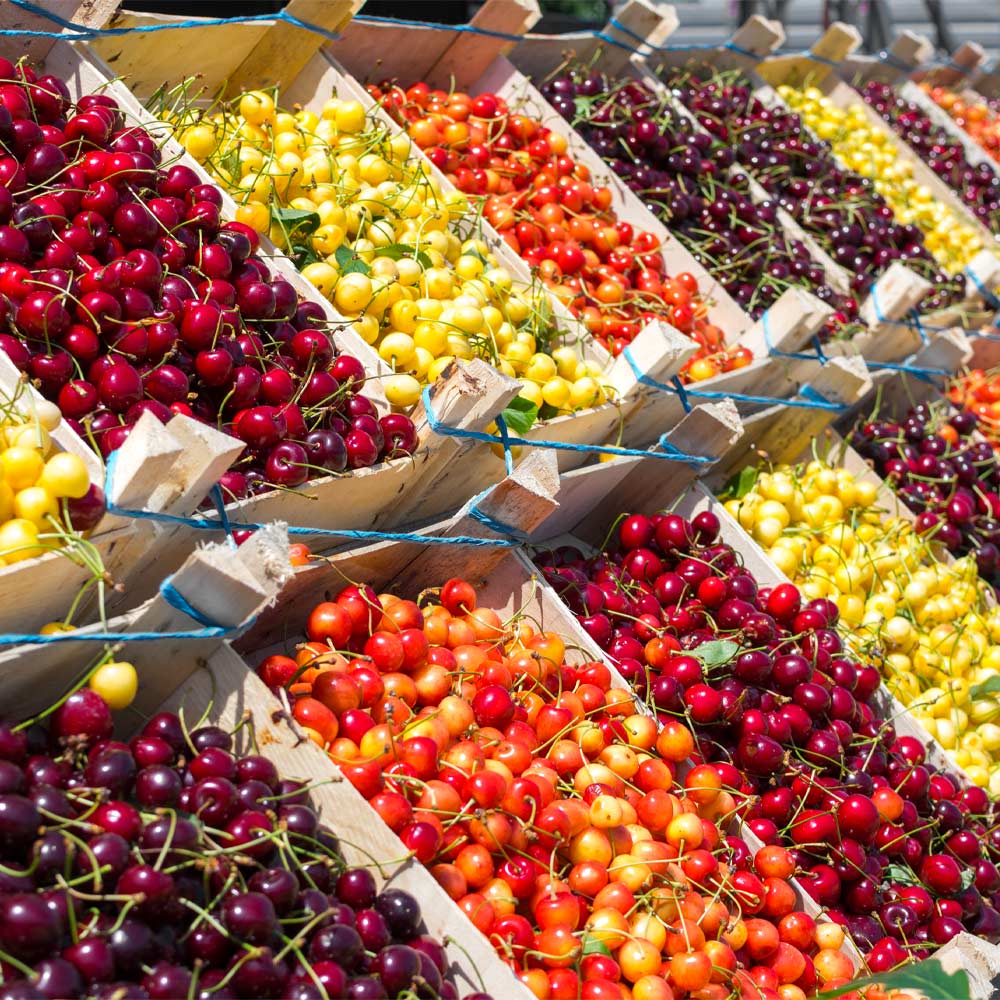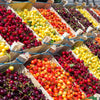* Images shown are of mature plants

Have questions? Talk with our Plant Experts (800) 973-8959
5 Kinds of Cherries From a Single Tree
Pick Cherries for Months, Not Weeks
Five popular types of cherries are grafted into one tree. Early-growth varieties are combined with an assortment of late-growth types of cherries for an extended growing season. Rather than receiving your bounty of cherries all at once, you can enjoy fresh cherries at their peak of ripeness for months.
While we can't guarantee the Cherry varieties you'll get on this tree, you will get five varieties of delicious, home-grown fruit to enjoy for years to come!
Takes Very Little Space
These compact trees grow to about 15 feet, but most people prune them back to a shorter stature. They'll thrive wherever they're planted - in small yards - and even in containers. Bred to be prolific fruiters...you will enjoy bushels of sweet delicious cherries from even the smallest tree. Continuously pruned branches give you more cherries at safe picking height. These thicker branches can mean up to twice the fruit as a normal tree.
Simply Plant and Pick
Cherries are one of the easiest fruit trees to grow. Your 5-in-1 Cherry is self-pollinating, so you don't need a second tree.
Large Trees that Produce the First Season
You get a bearing age tree that is several years old. The five popular varieties were carefully selected to grow well together. Third generation fruit tree growers have perfected this tree over the decades.
Order Now
Our 5-in-1 trees will definitely sell out. So order while supplies are available.
Pollination Info
5-in-1 Cherry Tree Pollination
5-in-1 Cherry Trees are self-fertile. You will get fruit with only one plant. However, adding an additional 5-in-1 Cherry Tree will drastically increase the size of your crop.
Planting & Care
The multi-grafted cherry is a unique tree that gives you several varieties of cherries with just one tree, this multiple graft cherry (Prunus avium sp.) is a pleasure to watch bloom and fruit. Growing in USDA zones 5-8, they can tolerate cold down to -10 degrees and do not require a lot of chill hours, so they can also grow in the south and still produce fruit. This semi-dwarf fruit tree does not take up a lot of space in your landscape while still providing you with multiple varieties of cherries. Only reaching 15-20 feet tall and 10 feet wide, it’s a great way to have several varieties of cherry without having to have an orchard to do so. The multi-grafted cherry does not require a pollinator as the different grafts naturally cross-pollinate with one another!
Location: Choose a sunny spot that will give your cherry tree a minimum of 6 hours of direct sunlight per day. Although it will thrive in almost any kind of soil, avoid locations where the soil will remain soggy for prolonged lengths of time.
Planting Instructions:
1) Dig a hole that is as deep as the root ball and three times as wide.
2) Place the roots in the hole and fill the hole about half-way with soil, tamp to remove air pockets then fill the hole completely.
3) Water to secure the tree and remove any additional air pockets in the soil.
4) Add more soil if necessary after settling.
5) Spread a layer of mulch over the soil around your cherry tree to help keep the soil moist, encourage healthy growth and protect your tree against competing growth.
Watering: For the first week, water your tree daily. In the second week, switch to every other day, then reduce to once a week after the first month. Check the soil often during hot weather—your tree may need extra water. In heavy soils, let the soil dry between waterings. Once established (after one to two years), the tree can usually rely on rainfall, needing only a few inches every 10 days. During hot, dry periods, add extra water as needed. The best method is to use a slow-trickling hose at the base for about 30 seconds once a week. If you’re unsure, check the soil 2–3 inches down; if it’s dry, it’s time to water.
Pruning: A year after planting your cherry tree, prune your tree in the late to end of winter while dormant. Shape the tree to encourage horizontal branch growth with space between branches. Prune once a year as necessary to remove weak, drooping branches. These are usually poor fruit-bearing branches and removing them will encourage positive air flow and healthy growth. Also, make sure light can penetrate the center of the canopy.
Fertilization: Good, nutrient-rich soil should only require the addition of nitrogen. Fertilize in the spring and midsummer using nitrogen fertilizer twice annually applying 2 weeks after planting and 4 weeks after the first application. Use a complete fertilizer such as 10-10-10 and apply at the rate of 0.05 pounds of actual nitrogen per dose. Fertilizer application ratios vary upon the formulation so be sure to follow package directions. When applying, be sure fertilizer is 6 to 8 inches away from the trunk around the tree to prevent the roots from burning. Organic fertilizers such as manure or blood meal are highly discouraged as their nitrogen levels cannot be measured. Keep in mind that cherry trees require high levels of nitrogen early in the season and lower levels during the late summer.
Shipping Details
Estimated Shipping Time: Most orders ship immediately. As noted on the website, some items are seasonal, and may only ship in spring or fall. Once your order is shipped, you'll receive an email with a tracking number.
| Amount of Order | Shipping Charge |
|---|---|
| Less than $49 | $19.95 |
| $49 + | FREE SHIPPING! |
Product Details
| Mature Height: | 15-20 ft. |
| Mature Width: | 8-10 ft. |
| Sunlight: | Full Sun |
| Growth Rate: | Fast Growing |
| Harvest Time: | April - May |
| Botanical Name: | Prunus avium sp. |
| Does Not Ship To: | AK, AZ, CA, CO, HI, ID, OR, WA |
| Grows Well In Zones: | 5-8 outdoors |
| Your Growing Zone: | # |



